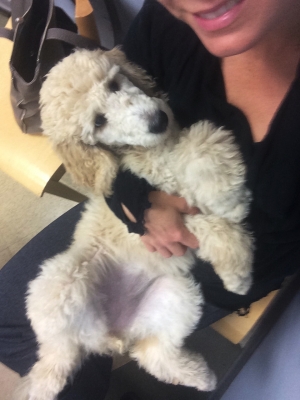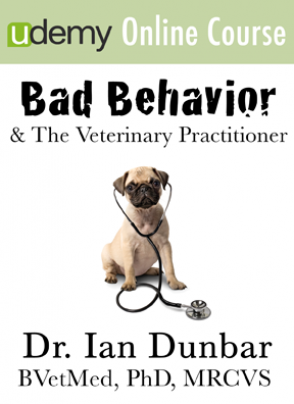Day 1: Business, Promotion, People Training and Games
Why Don’t We Adequately Socialize Young Puppies With People?

Dogs may be taught manners and basic obedience at anytime in their lives. However, training puppies is just so much fun and so, why wait? Similarly, behavior problems may be resolved at any time in a dog’s life but of course, they are annoying and frustrating for owners and so, why not teach good habits from the outset? Temperament problems, however, must be prevented during early puppyhood because rehabilitating adult dogs is complicated and extremely time-consuming. For example, whereas It takes just a few days, or a week at the most, to resolve incipient signs of shyness, fearfulness, intractability, or aggression towards people in a two- to three-month-old puppy, it would take several months to resolve similar problems in a five-month old adolescent and one or two years to rehabilitate a fearful/aggressive eight-month-old, (provided that the dog is not dangerous, i.e., has never actually harmed a person). Even then, the adult dog will never have the confidence that it could have had if given adequate socialization as a young puppy.
Without a doubt, the most important aspect of dog husbandry comprises raising dogs to thoroughly enjoy the company and actions of people, especially children, men and strangers, i.e., raising “bomb-proof” dogs. Confident and friendly dogs can have the time of their lives and enjoy meeting and interacting with household visitors and friends and strangers on walks, in parks and at picnics. However, a dog that’s afraid of people has a miserable quality of life for life. Living in a world of people, every day the poor dog has to confront his biggest fear — people. Or, the dog is put away when visitors arrive and seldom taken on walks. This is all so sad, especially given that fear and aggression towards people are so easily preventable with adequate early socialization.
Dogs are altrical and require some time to develop and socialize. However, there are still urgent time limits. Puppies must be socialized before three months of age and sadly, many breeders and owners are missing the boat. Prior to eight weeks of age, puppies need to be safely and gently exposed to as many different environments as possible and to interact with and be hugged, handled, handfed and trained by at least 100 people, especially children, strangers and men and then, by at least another 100 people during the first month in their new homes. Amazingly, neonatal handling alone can desensitize nine of the 12 most common subliminal bite triggers.
Predictable and Preventable
We know that insufficient early socialization causes hard-to-reverse changes in brain function and anatomy, leading to temperament problems later in life, such as fear and aggression towards people. We know these problems are difficult and time-consuming to attempt to resolve in adulthood, yet may be so easily prevented with ample early socialization and handling. We know that socializing puppies with people is as easy as it is enjoyable. And so, it has puzzled me for years why far too few breeders and owners adequately socialize young puppies. In fact, so few kennel-bred puppies get to meet and socialize with more than a handful of people, yet at eight-weeks of age, the Critical Period of Socialization is nearly two-thirds over!
Certainly some breeders devote plenty of time and energy socializing their litters with oodles of people. But most don’t. Why don’t all pet professionals (breeders, pet product retailers, veterinarians, trainers and shelter/rescue personnel) inform prospective owners that when they purchase a puppy they have a choice? Either people may purchase a puppy that is already well-socialized, or they may buy a pup that has grown up in relative seclusion and is highly likely to become increasingly fearful during adolescence.
And once people have chosen a puppy, especially if it’s a sensitive, aloof, standoffish, or protective breed, why don’t all pet professionals inform new puppy owners that there is now an excruciating urgency to socialize their puppy (at home) with family, friends, neighbors and strangers during the remaining five weeks of the Critical Period of Socialization?
Regardless of what happened, or didn’t happen, in the breeding kennel, socialization with people is now by far the most crucial item of their pups’ educational agenda. A puppy’s future temperament is pretty much determined during the first three months of life.
So, Why Don’t We Adequately Socialize Puppies?
I think there are a whole slew of reasons why many breeders and owners don’t adequately socialize young puppies, or suitably mold their temperaments to individual tastes. Most people simply don’t see the point of socializing apparently sociable puppies and since the early warning signs of fear and aggression are often subtle and easily missed, no one realizes there is a problem. Other people think that it is impossible to change genetic heredity, that early socialization is too stressful, or they are afraid of disease, (especially parvovirus). Far too many owners think that their pup may be adequately socialized in puppy classes and other owners are in denial about developing problems — “She’ll grow out of it.”
Why Socialize Apparently Friendly and Confident Puppies?
Many breeders, veterinarians and owners simply don’t see the point of early socialization and handling because the puppies are easy to handle and already appear to be confident and friendly. In fact, many young pups appear to be super-mega-confident and overly-friendly and so, why socialize sociable puppies? Consequently, people are predictably shocked when at about five-and-a-half to eight months of age, their friendly and socialized puppy becomes shy, aloof, wary, standoffish, protective, fearful, reactive and maybe aggressive towards people.
Of course puppies are confident and friendly and easy to handle. They’re puppies! All young pups should be universally outgoing towards people. Fear and aggression do not develop until later in life. Moreover, developing anxieties and fears of the unfamiliar or scary later in life is a normal and adaptive development process. Adolescent and adult dogs will generally accept species and individuals that they played with as puppies yet they will likely shy away from species and individuals that they did not have adequate opportunity to interact with as puppies. To prevent fear and aggression, the unfamiliar and scary of adolescence must become the familiar and commonplace of puppyhood.
The socialization process is deceptive because all puppies appear to be Mr. or Ms. Sociable at two, three and four months of age and so breeders, veterinarians and owners are unaware that anything is amiss. People are duped by their puppy’s confident and friendly demeanor, not realizing that the effects of insufficient socialization will not become apparent until later in life. But by then of course, it is pretty much too late for quick, easy and effective rehabilitation.
Early Warning Signs Missed
When puppies and young adolescents start to go off-track, the early-warning signs (evident as early as eight to 10 weeks of age) of future aggression are often subtle and easily missed and so, people simply do not respond quickly enough. For example, many owners fail to notice that the puppy is slow to approach some family members, that the pup ducks his head or backs off when reached for, or most important, the puppy does not play with and play-bite other puppies and no longer bites the owners. If the puppy is no longer biting, he cannot develop bite inhibition and when he bites as an adult, he will likely cause serious injury. Most adult dog bites may be predicted during early puppyhood and the prognosis (danger) of biting is pretty much determined by the level of bite inhibition.
Many owners think nothing of the fact that the puppy freezes or struggles when held. In fact, some owners consider struggling when restrained to be an annoyance, or a sign of a “dominant” dog that requires a heavy hand to teach him “who’s the boss” and so sadly, exacerbate the puppy’s fears. Without immediate remedial socialization, classical conditioning and progressive desensitization, puppies gradually but progressively become more fearful and eventually, reactive and aggressive. Again, this is normal development; becoming wary of unfamiliar animals, especially people, is a highly adaptive trait. Unfortunately, by the time the owner notices that their young adolescent dog has a “real” problem, the Critical Period of Socialization is long gone and now rehabilitation will take much (MUCH) longer.
You Can’t Change Genetic Heredity
The dog profession has long harbored an enormous bias towards genetic, rather than experiential, causes of behavior and temperament. For years, the notion has been that temperament is immutable and caused entirely by genetic heredity. However, my research in the 70s proved that temperament is extremely malleable in young puppies. A number of our pups underwent speedy and dramatic changes in temperament arising from their early social experiences.
SIRIUS® Puppy Training pretty much pioneered the field of temperament training. SIRIUS classes have always focused on molding puppy temperament — building confidence in shy and fearful pups, toning down bullies, calming hyperactivity and teaching puppies to thoroughly enjoy being hugged and handled (restrained and examined) by family members and strangers, especially children and men.
The Nature/Nurture debate has been going on for several hundred years — essentially, whether good dogs are bred, or raised. Personally, I wouldn’t waste time and energy arguing the issue. I would do both — breed the best and give them the very best upbringing. However, just because Jack Russells grow up to act like Jack Russells and Goldens act like Goldens, doesn’t necessary mean that the process is 100% due to genetic heredity. On the contrary, many other experiential factors, especially social heredity, come into play and have enormous effects on developing behavior and temperament. Simple cross-fostering experiments provide proof. For example, what would happen if a JRT puppy were raised in a litter of Goldens and a Golden puppy in a litter of JRTs? Most likely, the Golden puppy would learn to put up or shut up and the JRT pup would spend a lot of time lounging on her back, soaking up the sunshine, with her tail lazily a wag, only to occasionally get up to obsessively retrieve a tissue, twig, or ball.
My son, Jamie, offers a fine example of the relative effects of genes vs. environment. When he was four years old, I once asked him to introduce himself to a dog seminar audience and he said, “My name’s Jamie. I’m half Chinese and half English … but … I’m ALL American.” Not an American (USA) gene in his body but he grew up acting American because he grew up in the USA around American kids and their hobbies and interests. He hardly thrills at the English sounds of tungsten on pig bristle, or willow on leather. (But he does have a delightful sense of humor and cooks pretty good Chinese food.)
When we domesticated animals, we selectively bred for those that were more easily and quickly socialized and trained but we tend to forget that a domestic animal is not fully domesticated until it has been fully socialized and trained.
Yes, all breeds and types of dog are different but without a doubt, regardless of breed or breeding, the single biggest variable that affects a dog’s temperament and personality and hence, its value and delight as a companion, is whether or not it was adequately socialized, handled and trained as a puppy. Pick any breed or type you like, mixed breed or Malamute, pitbull or Pomeranian, collie or Chihuahua and consider two individuals: one that was socialized and trained as a puppy and one that was not.
Socialization is Too Stressful for Young Puppies
Puppies are highly unlikely to be dangerously stressed by “too much” socialization and handling. On the contrary, it is a lack of early socialization that condemns many puppies to a miserable quality of life. Anxiety towards people is excruciatingly painful for dogs, especially when forced to confront people every day. Also, living with an anxious or fearful dog is not much fun for their owners, who cannot enjoy walking their dogs and even have to put the dog in a different room when people visit.
When over-stimulated or overwhelmed, young puppies simply fall asleep (to solidify the experiences) and then wake up raring to go again. Neonatal handling may cause short-term, slight increases in corticosteroid levels but puppies that were handled regularly as youngsters experience lesser corticosteroid spikes when handled or confronted with novel or fear-invoking stimuli later in life compared with dogs that were seldom handled as puppies. Essentially, early handling sets the “hormonostat” and enables puppies to cope better with stress during adulthood.
Risk of Parvovirus Infection
There is no need to expose a young puppy to any risk of parvovirus infection when socializing puppies with people. Prior to three months of age, puppies may be safely socialized in the breeding kennel, or in their new homes, provided that outdoor shoes remain outside. Rather than taking puppies to the people, bring the people to the puppies. Have puppy parties four nights a week, wherein all guests, especially children, men and strangers, gently handle and train the puppy. (When you have a young puppy, your social life will improve as well.)
We must triage the various aspects of socialization — socialization with people, socialization with dogs, and exposure to different physical aspects of the environment. Socializing puppies with people is extremely urgent, beyond important and completely safe, whereas socializing puppies with other puppies/dogs is less urgent, less important and may carry a minimally greater risk of parvovirus infection. Nonetheless, there is simply no scientific evidence that puppy classes cause an increased incidence of parvovirus. The real risk of parvovirus infection comes from puppies, with little or no immunity, sniffing the ground in contaminated areas, such as low-income (low-vaccination) public spaces and of course, veterinary clinic car parks. Even so, parvovirus infection is seldom fatal with appropriate treatment.
We Can Adequately Socialize Our Puppy in Puppy Class
Puppy classes are truly wonderful but they offer too little too late. Puppy classes are not a place to socialize barely socialized puppies. Instead puppy classes provide a safe forum for socialized puppies to continue socialization under the watchful eye of a trainer on the look out for warning signs of incipient temperament problems, especially fearfulness and aggression towards people, so that they may take immediately remedial action.
Denial
Some owners notice warning signs but ignore them, or they euphemistically excuse the puppy’s behavior, thinking that it’s no big deal. The Springer Spaniel that gave me the light-bulb moment for the notion of subliminal bite stimuli was described to me by the owners as: “She takes a while to warm to strangers”, “She’s not overly fond of children”, “She’s a bit hand-shy”, “She’s a bit tricky around her food bowl” and “We thought she would grow out of it.” Absolute denial! No she won’t grow out of it unless you help her. She is anxious and she’s crippled inside! She hurts!!! And so, pleeeeeease do something to resolve her fears and anxieties right away. If you do nothing, she will not get better; she’ll get worse. Behavior and temperament never stay the same. Behavior and temperament are in a state of constant flux and are always changing from day to day depending on experiences.
I feel so sad when I think of the number of times that I just wished I could turn the clock back for owners of fearful and aggressive adolescent and adult dogs and give them advice so that they could produce a dog as lovely and as bombproof as our American Bulldog, Dune. Yes, he was well-bred but also, he benefited from a social upbringing that was second to none. He was happily friendly and accepting to babies and toddlers, men and boys, strangers and street people, kittens, puppies, chickens, goats, horses, deer, squirrels, little dogs, big dogs, overly friendly dogs and unfriendly dogs. And the fun we had with him and the moments and memories he left.
Prevention is the only way — early handling, oodles of classical conditioning and lots of puppy parties with lots of people, especially children, strangers and men. Socialize your puppy to the max. And if you have a breed that has been described as being sensitive, aloof, standoffish, or protective etc., your puppy requires more socialization, not less.
Above all, please remember that neglecting to socialize puppies with people is probably the most abusive thing that we can do to dogs. The effects are crippling and stay with the dog for a lifetime. To paraphrase Frederick Douglas, “It’s easier to build strong puppies than to repair broken dogs.”
All the relevant information for breeders, new puppy owners and veterinarians is available at https://www.siriuspup.com/resources including two of my books — BEFORE You Get Your Puppy and AFTER You Get Your Puppy — that may be downloaded for free. Please download these two books and email them to every doggy person and dog professional that you know.
To help prospective owners locate puppies that are already well-socialized, SIRIUS® Puppy Training is compiling a US database for breeders who are taking the time to raise their litters according to the SIRIUS® Minimal Mental Health Guidelines for Puppies. This is an opt-in program and any interested breeders should contact [email protected] and we’ll provide you with the behavior guidelines.










